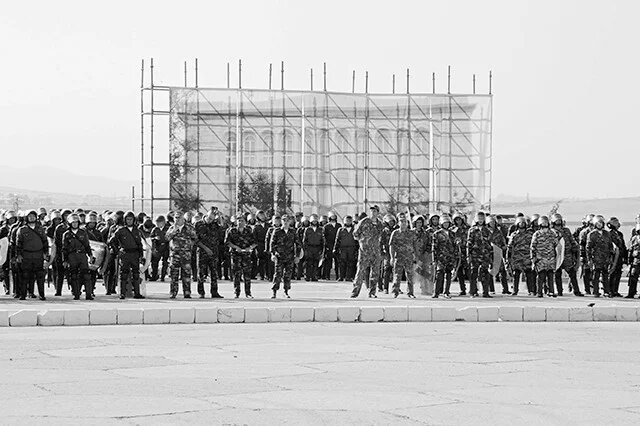Judicial reforms have been high on the new democratic reforms’ agenda of Armenia since the 2018 Revolution as the low level of trust in the judiciary was one of the reasons behind the Velvet Revolution. The historical context of the continuous judicial reforms in Armenia shows that the legislative framework and constitutional guarantees cannot ensure the independence and impartiality of the judiciary unless there is a genuine political will. Meanwhile, the events and actions that took place after the Revolution show that the vetting is indispensable for restoring the confidence in the judiciary which is one of the essential prerequisites of the democratic development of Armenia.

Armenia’s judicial system after re-gaining independence
Judicial independence is a cornerstone of any democratic society, it is an essential element of the rule of law and a precondition for the effective realization of all human rights. On the one hand, maintaining an independent and impartial judiciary is a safeguard of democracy, on the other hand, it is a binding obligation undertaken by Armenia under international and regional treaties in the scope of ensuring the right to a fair trial.
After declaring its independence in 1991, Armenia took steps to create its own judicial system and legislative framework for its functioning. The adoption of the Constitution of Armenia in 1995 laid the basis for the establishment of the domestic judicial structure, which was the starting point for judicial and legal reforms in Armenia. The 1995 Constitution had a historical importance for the formation of the Armenian legal system, still it did not provide for sufficient guarantees of external and internal independence of the judiciary. The President and the executive had significant influence on the processes related to the formation and functioning of the judiciary. The Council of Justice was chaired by the President of the Republic of Armenia, whereas the Minister of Justice and the Prosecutor General served as Deputies to the Chairman of the Council. The Council consisted of 14 members appointed by the President, out of which three were prosecutors.
Further efforts to strengthen the constitutional guarantees of judicial independence were undertaken in the scope of the Constitutional amendments adopted in 2005. They introduced significant changes to the regulations on the judiciary and were intended to reduce the President's role in court-related processes; the Ministry of Justice was deprived of its authority in the appointment process of judges; the Council of Justice was completely reformed. According to Article 94.1 of the RA Constitution with amendments of 2005, the Council of Justice consisted of nine judges, elected by the General Assembly of Judges of the Republic of Armenia by a secret vote, for a term of five years; the President of the Republic and the National Assembly each appointed two academic lawyers. The Chairperson of the Court of Cassation chaired the sittings of the Council of Justice, without a voting right.
Finally, a new constitutional referendum was held in Armenia on 6 December 2015, which led to the adoption of a comprehensive package of amendments to the Constitution also having a significant impact on the judicial system. The amendments in the field of judiciary were intended to further enhance the guarantees of judicial independence and impartiality, inter alia, by reviewing the composition and election procedures of the Supreme Judicial Council (successor of the Council of Justice), increasing the role of the Parliament in the processes of formation of the judiciary, and strengthening guarantees of independence of the Constitutional court. Another important change was related to the mandate of the Supreme Judicial Council which was proclaimed as an independent state body entitled to guarantee the independence of courts and judges.
The adoption of the Constitution in 1995 as well as subsequent amendments to it entailed processes of systematic judicial and legal reform in Armenia. The first judicial reform was implemented right after the adoption of the 1995 Constitution, whereas the second round of reforms followed constitutional amendments approved in the national referendum at the end of 2005. These reforms were followed by the adoption of several judicial and legal reforms strategies and action plans: 2009-2011 Strategic Action Plan for Judicial and Legal Reforms and the List of Measures deriving therefrom, the 2012-2016 Strategic Plan of Legal and Judicial Reforms of the Republic of Armenia, with the List of Measures and the Schedule of Implementation deriving therefrom, 2019-2023 Strategy of Judicial and Legal Reforms of the Republic of Armenia and Action Plan deriving therefrom, 2022-2026 Strategy of Judicial and Legal Reforms of the Republic of Armenia and Action Plan deriving therefrom. By and large, the reforms had declared goals of establishing and strengthening an independent and impartial judiciary in Armenia, as well as enhancing its efficiency.
Due to the lack of the political will of the previous regime to establish a truly independent judiciary, any assessment of the implementation of judicial reform strategies and respective action plans needs to distinguish between the periods before and after the Velvet Revolution of 2018.
The old regime: lack of judicial independence
It has to be acknowledged that a number of important steps have been undertaken in the scope of the judicial reforms implemented before the 2018 Revolution, including the establishment of the core institutional and legislative basis for the functioning of the national judicial system, and the adoption of the main procedural codes and basic legal framework deriving from the Constitution of RA. Nevertheless, the main goals declared by the Constitution as well as the 2009-2011 and the 2012-2016 Strategic Action Plans were not achieved, in particular, an independent and accountable judiciary never became a reality. Although the formal legal framework is an essential prerequisite for securing an independent and impartial judiciary and should be subject to permanent review and improvement, in certain circumstances it might become ineffective.
As the report on the “Challenges for judicial independence and impartiality in the member states of the Council of Europe” argues,
“as valuable as they are, constitutional guarantees, formal legal rules and institutional safeguards are not in themselves sufficient if the values of independence and the separation of powers, which form the basis of such rules, are lacking. All parties concerned must act according to a culture of independence and mutual respect to create and sustain this basis. The introduction of formal legal guarantees forms the starting point, not the completion of this culture of independence and mutual respect.”
The lack of political will to build a truly independent judicial system was one of the primary factors affecting the efficiency of the adopted judicial reform strategies. Meanwhile, the public confidence in the judiciary of Armenia was progressively diminishing. The UN Human Rights Committee in its concluding observations adopted in 2012 expressed concerns on allegations of persistent corruption among all branches of State institutions, especially the police and the judiciary that undermined the rule of law. In addition, the Committee raised issues on the lack of convincing results in the fight against high-level corruption and the resulting lack of public trust in the administration of justice. According to a survey conducted by Transparency International for the Global Corruption Barometer 2013, 69% of the respondents in Armenia considered the judicial system corrupt or extremely corrupt, and 18% of the respondents indicated that they had themselves bribed court officials. The Commissioner for Human Rights of the Council of Europe in his 2015 Report described the significant level of corruption in the judiciary of Armenia which had been reported as a matter of serious concern.
According to the 2017 Human Rights Report Armenia published by the United States Department of State Bureau of Democracy, Human Rights and Labor,
″although the law provides for an independent judiciary, the judiciary did not generally exhibit independence and impartiality. (…) According to some human rights groups, the Court of Cassation’s control over judicial decisions remained an overarching problem affecting judicial independence. Judges remained subject to political pressure from every level of the executive branch, from law enforcement agencies, and the judicial hierarchy″.
Issues related to internal pressures within the judiciary were also raised in the Joint Opinion of the Venice Commission and the Council of Europe Directorate of Human Rights on the Draft Law Amending and Supplementing the Judicial Code of Armenia, in particular, it referred to persistent reports of improper and extraordinary interference by judges of higher-level courts with those of lower level ones.
Systemic issues related to corruption as well as lack of judicial independence were revealed in the 2013 Ad-Hoc Report of the Human Rights Defender of the RA on the Right to a Fair Trial. The report revealed large-scale illegal coordination of judicial acts between the judges of Court of Cassation and lower court judges, referring to the ″zone judges″ of the Cassation Court which had to provide instructions on sensitive cases to others. As the report states, ″existing pressures on judges and the repressive mechanisms used to implement them led to a situation where lower court judges often turned into functionaries performing technical work″ (Ad-Hoc Report, 2013, p. 11). The Ad-Hoc Report described the Council of Justice as a tool for pressure through which the Court of Cassation exerted direct and indirect influence on judges. In particular, the whole system of disciplinary liability to suppress judges was based on double standards. The judge conforming with the instructions of the higher-instance court judges, as a rule, would not bear responsibility for his misconduct, whereas ″disobedient″ judges would be subjected to liability or even stricter disciplinary liability for the same violation. At the same time, according to the Report, disciplinary proceedings were not initiated against the judges of the Court of Cassation in cases of the violations for which proceedings had been initiated in respect of the lower instance court judges.
From lack of justice to the 2018 Velvet Revolution
The described situation frequently amounted to the denial of justice, especially in politically sensitive cases. Thus, the extremely low level of public trust in the justice system was one of the reasons behind the 2018 Revolution, which, in its turn, entailed the need for comprehensive reforms in the justice sector. The absolute necessity for such reforms was also acknowledged by the 2019-2023 Strategy of Judicial and Legal Reforms of the Republic of Armenia adopted after the Revolution.
Post-2018: to vet or not to vet
Nevertheless, the primary intention of the Government to implement a comprehensive vetting of judges was later abandoned. The Government explained this with the outcomes of the dialogue with the international partners and the Armenian civil society.
On 25 March 2020 the Parliament adopted a Law on making amendments to the Judicial Code of the RA which was presented as a «vetting» initiative. Although the package of amendments included a number of positive developments, including integrity checks of candidates for judges, it had nothing to do with the extraordinary vetting procedure as a tool of transitional justice and was not able to address the existing situation in the judiciary. Yet, several controversial events followed the 2018 Revolution, including the call of the Prime Minister to block the entrances and exits of the courts which was stipulated by the decision of the court to release the former president of Armenia R. Kocharyan from the pre-trial detention in connection with the instituted criminal proceedings on 1 March 2008 events. Strong tensions within and around the judiciary, inter alia connected with the alleged influence of the former authorities on the judiciary, as well as the crisis around the Constitutional court displayed the evident lack of substantive actions in the justice sector. Judges famous for their predictable decisions in the politically sensitive cases, including cases relating to the events of March 1, 2008 and cases of expropriation continued to hold their office; this was another factor contributing to the unchanged public attitude towards the judiciary.
It can be argued that the comprehensive vetting of judges still remains the only efficient measure to address the structural problems in the Armenian judiciary and restore the public confidence towards it.
The persistent public demand for the vetting of judges led to the new round of discussions on the possibility of conducting a comprehensive vetting of judges under the current constitutional framework. These discussions ended with a conclusion on the indispensability of constitutional amendments. However, it can also be argued that the vetting can be carried out by an independent commission established by law if the final decision is to be adopted by the Supreme Judicial Council. The argument is based on the provision in the current Constitution allowing for the establishment of additional incompatibility requirements for judges by the Judicial Code whereas the potential conflict with the Constitution is resolved if the commission does not acquire an authority of terminating judge’s powers. Hence, if such an independent commission was established, it could restrict itself to preparing a motion substantiating the incompatibility of the existing judge with the preliminary established criteria and defending it in the Supreme Judicial Council, with adequate public oversight.
Restoring public trust: improving the quality of justice
Restoring the public confidence in courts is an essential precondition for the proper functioning of the judiciary. At the same time, the credibility of the judiciary is also closely connected with the quality of justice: judicial reasoning and legal certainty are important factors affecting public trust in the judiciary. Even so, there are serious problems relating to the reasoning of judicial acts at the admissibility stage in the Court of Cassation.
In particular, the Constitutional Court adopted a wide range of decisions implying the obligation of proper justification of the admissibility decisions by the Court of Cassation, still, the Court’s practice has not changed. The majority of the cassation appeals are not accepted for examination while admissibility decisions do not provide for any substantive reasoning deriving from the case. They consist of generic sentences and phrases applicable to all types of cases. This kind of practice, in its turn, leads to the contradictions in the case law of the Cassation Court even though it is entrusted with the mandate of ensuring unified application of the law.
The absence of proper reasoning in the Cassation Court’s practice was also emphasized in the RA Constitutional Court’s decisions. . In particular, in one of the decisions the Constitutional Court stated:
“In this case, the Court of Cassation, in not admitting the applicant's appeal, ignored the apparent contradiction of the decisions of the Court of First Instance and Court of Appeal with the legal positions expressed in its own decisions; in other words it arbitrarily deviated from its positions without the necessary justifications, which led to a breach of the applicant’s rights.”
Consequently, the arbitrary practice of accepting or rejecting appeals by the Court of Cassation without proper reasoning is another key factor affecting public trust and confidence in the judiciary. Accordingly, a comprehensive justice reform should cover not only the extraordinary vetting procedure but also issues of quality of justice which will in its turn entail legal education reform aimed at changing the general system of values.
The content of the publication is the sole responsibility of the author and can in no way be taken to reflect the views of the Heinrich Boell Stiftung Tbilisi Office – South Caucasus Region.
See the 1995 Constitution of the Republic of Armenia, article 94, available at https://www.arlis.am/DocumentView.aspx?DocID=1
See the 1995 Constitution of the Republic of Armenia with amendments of 2005, available at https://www.arlis.am/DocumentView.aspx?DocID=75780
See the 1995 Constitution of the Republic of Armenia with amendments of 2015, available at https://www.arlis.am/DocumentView.aspx?DocID=143723
Executive Order of the President of the Republic of Armenia N-ՆԿ-59-Ն of 21 April 2009, available at https://www.arlis.am/DocumentView.aspx?DocID=66236
Executive Order of the President of the Republic of Armenia N-ՆԿ-96-Ա of 30.06.2012, available at https://www.arlis.am/DocumentView.aspx?docid=76932. The time frame of the Plan was later extended until the end of 2017.
RA Government Decree N 1441-Լ of 10.10.2019, available at https://www.arlis.am/DocumentView.aspx?DocID=135487
RA Government Decree N 1133-Լ of 21.07.2022, available at https://www.arlis.am/DocumentView.aspx?DocID=166582
Challenges for judicial independence and impartiality in the member states of the Council of Europe”, Report prepared jointly by the Bureau of the CCJE and the Bureau of the CCPE, 24 March 2016, Information Documents SG/Inf(2016)3rev, available at https://rm.coe.int/1680630e3a
Concluding observations adopted by the Human Rights Committee at its 105th session, 9-27 July 2012, Armenia, available at https://www.icj.org/wp-content/uploads/2012/08/Concluding-Observations-CCPR-Armenia-2012-eng.pdf
Global Corruption 2013 Survey Armenia Findings, available at https://transparency.am/storage/GCB2013_en.pdf
Report by Nils Muižnieks, Commissioner for Human Rights of the Council of Europe following his visit to Armenia from 5 to 9 October 2014, Strasbourg, 10 March 2015 CommDH(2015)2, available at https://rm.coe.int/ref/CommDH(2015)2
CDL-AD(2014)007, available at https://www.venice.coe.int/webforms/documents/default.aspx?pdffile=CDL-AD(2014)007-e
Ad-Hoc Report of the Human Rights Defender of the RA on the Right to a Fair Trial, 2013, available at https://www.ombuds.am/images/files/2ddebfe4a4ecb335d3cfd24f3cef719e.pdf


